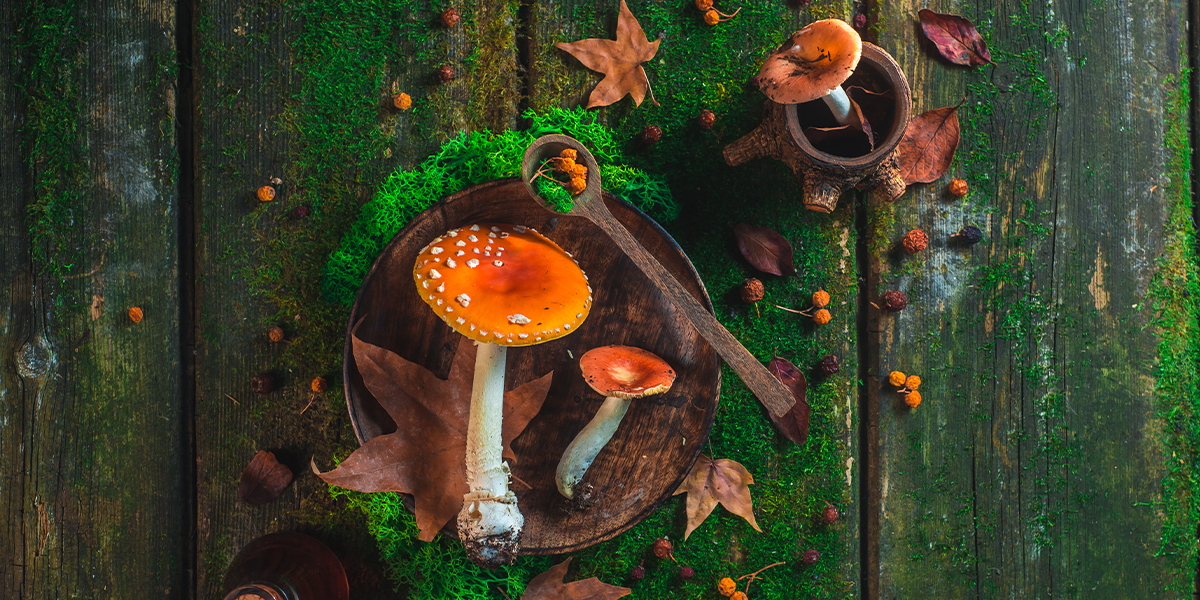The fly agaric (Amanita muscaria) and the panther cap (Amanita pantherina) are the fungi most commonly referred to as the fool’s mushrooms, which “intoxicate people with their poison”. Shamans used these psychedelic and hallucinogenic mushrooms mainly in the northern hemisphere among the Uralic and Siberian peoples.
According to researchers, we can connect the possibility of Amanita muscaria consumption to peoples whose language has preserved traces of the practice (such as the term “fool’s mushroom”), such as the Nordic, Baltic, and Siberian peoples. Word has it that until recently, in Siberia, indigenous Ob-Ugric communities, Voguls, and Mansi tribes used fly agaric for various rituals.
There’s a theory that the ‘ancestor’ of the red-clad Santa Claus of Lapland is a shaman on mushrooms whose sleigh is pulled by a reindeer also under the influence of hallucinogenic mushrooms, as reindeer like to consume Amanita muscaria, hence the legend of the flying sleigh. Some also believe that the fly agaric is the predecessor of the Christmas tree ornaments, as shamans used to dry the mushrooms they collected and hung them on trees. The gesture of gift-giving could also be linked to the cult of consuming mushrooms: shamans are said to have taken dried mushrooms to all the families in the community so that no one would miss out on this unique experience.
In Hungarian, although rare, the poisonous mushroom death cap (Amanita phalloides) and destroying angel (Amanita verna) are also referred to as the fool’s mushrooms, although eating them causes death instead of a trance.
The panther cap differs from the fly agaric as it contains no muscarine. Other members of the genus include the gemmed amanita (Amanita gemmata), which also contains ibotenic acid, and the royal fly agaric (Amanita regalis), which resembles the fly agaric, differing only in the color of its cap and prefers high mountainous areas.
There are also several popular sayings about mushrooms, such as “talks like he’s been eating crazy mushrooms”, which is said about someone who talks nonsensically and incoherently. Another expression – “I haven’t eaten crazy mushrooms” – means that the speaker is consciously emphasizing their sanity about an idea considered crazy, e.g. “I wasn’t crazy to do that”.
From flies to visual icon: the fly agaric is the best-known fungus
The fly agaric is believed to be the world’s oldest hallucinogenic mushroom. It’s found in most areas of the northern hemisphere, which is why it has become a visual icon for all species of fungi: from storybook illustrations to emoticons, you can bump into its red hat with white spots everywhere.
This mushroom generally likes cooler temperatures, so it’s more frequent in northern countries and higher mountains. The Latin name stands from the fact that, in the past, its poison was smeared on paper on which flies flew and died.
The mushroom’s cap is hemispherical, 10-20 cm wide, red, sometimes orange, or yellowish-brown when older. The white patches are the remains of a coating. When the rain washes them away, the hat remains completely red. The stipe of this mushroom is also white and has a large ring hanging on it. It grows from July to October or November, and you can find it mostly in pine, birch, and oak forests.
It is generally considered a poisonous fungus but causes complications especially when ingested by children or elderly people. Because it has a distinctive appearance, it’s hard to confuse with edible mushrooms, further reducing the chances of poisoning. If it reaches the human body, symptoms of poisoning can include dizziness, drowsiness, drunkenness, hallucinations, sweating, tearing, abdominal pain, and profuse salivation. Researchers are still investigating what exactly are the substances responsible for these symptoms: probably, several alkaloids (ibotenic acid, muscimol, and muscazone) produce the toxic and psychotic effects.
Shamans consumed fly agaric in several forms: dried, mixed into food, or as a brew. It was found that ingesting the urine of a person who had consumed this fungus also had a psychotic effect (the active substances do not break down in the urine).
Incidentally, it’s not only reindeer that like mushrooms: researchers have observed squirrels eating fly agaric and panther cap in the forests of Japan, with no fatal effects of the toxins afterward. Researchers hypothesize that it is likely that the fungal spores pass intact through the digestive tracts of squirrels, thus contributing to the spread of the fungi. In turn, the fungi contribute to the maintenance of forests: they play a key role in plant survival, as they can take up nutrients from the soil that plants cannot absorb, but as they connect to tree roots via filaments, the trees themselves benefit from these substances.
If you want to learn more interesting facts about fungi, read this article on misconceptions about edible and poisonous mushrooms, and in this article, we introduce you to special mushrooms from around the world.






